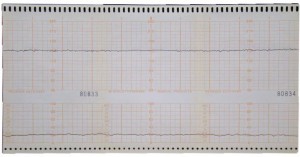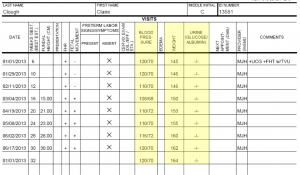This station was designed to test the student’s ability to perform a routine prenatal exam, and to properly react to the mother’s perception of decreased fetal movement.
The Students are Told:
Claire Clough is here at 32 weeks gestational age for a routine OB visit. Her chart indicates this has been an uneventful 1st pregnancy. Go in and evaluate Mrs. Clough.
The faculty member will serve both as in the role of Mrs. Clough’s voice (ask any questions you like), and will ask you a few questions.
Faculty:
The student will not know in advance that fetal movements are decreased.
If asked about FMs, you should respond: “I haven’t really felt any movement at all since yesterday morning.” The responses to any other questions should be normative (I’m trying to isolate this interaction to a single abnormality…decreased FM.)
Because this is both a testing and learning experience for the student, should the student not ask about FM, it is OK and desirable to prompt the student…just don’t give them any credit for asking about it.
As soon as they order an NST, give them the tracing, which is non-reactive (140, minimal variability, no accelerations, no decelerations, no contractions).
Expectations:
Students will introduce themselves, wash their hands, and perform a ROB visit
Students will quickly review the patient’s OB records
Students will inquire specifically about
- Fetal movement
- Vaginal bleeding
- Loss of fluid
- Vaginal disharge
- Contractions
- Any other symptoms
Students will examine the abdomen and record the fundal height
Students will check the extremities for edema
Students should recognize that decreased fetal movement is a problem, and one that requires immediate attention
Students should recommend immediate NST and AFI check for the patient.
If time permits, students should provide a reasonable list of possible causes for decreased FM.
Evaluation:
| Good Points | Bad Points | |
| General | Introduced themselves
Washed their hands Asked for any questions |
Inappropriate introduction |
| Inquired about | General health and symptoms
Fetal movement Loss of fluid Vaginal Bleeding Pain Contractions |
Inappropriate questions |
| Examined | Fundal height
FHT Extremities |
Unneeded examination |
| Assessment | Possible Fetal Jeopardy | “Everything is fine” |
| Immediate Plans | NST immediately
Ultrasound for AFI/BPP Ultrasound for fetal growth |
Delayed Evaluation
Unnecessary tests |
| NST | No contractions
Baseline 140 BPM Minimal variability No accelerations No decelerations Non-reactive |
“NST is normal” |
| Further Plans | To hospital
Further monitoring MFM consultation Consider early delivery Consider steroids |
Delayed intervention |
Faculty Assigned Overall (gestalt) Grade (1-4) ______________
1: FAIL – missed the point of the station, misread the NST as reassuring, care would result in fetal morbidity
2: MARGINAL PASS – Hit all the main points, with prompting. No major/catastrophic diagnostic errors
3: HIGH PASS – Hit all the main points without prompting, care was clinically appropriate
4: HONORS – Hit all main points and most details. Intern level
Materials:
Station 3 Decreased FM 2.7.2013
Student-3-Routine OB visit at 32 weeks


